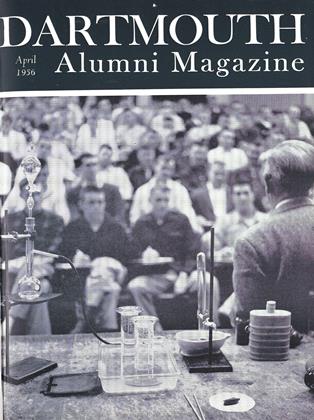IT will be nine-up later this month for the nineteenth running of the Harvard-Dartmouth slalom race on the headwall of Tuckerman Ravine, shown in Harold Orne's striking photograph above. Few intercollegiate rivalries are quite so informal as these contests open to an unlimited number of undergraduates and alumni from each institution.
In fact, the competition has been so unconventional through the years that a continuous record was not compiled until this past winter, when Richard F. Perkins '57 was encouraged by Bradford Washburn, Harvard '33 and originator of the idea for the race, to delve into D.O.C. records and newspaper files. Thanks largely to this sleuthing by Dick Perkins, the following highlights and much other information are now available.
The initial contest on April 29, 1934 must have had some of the pioneering aura of the first boat race between Harvard and Yale on Lake Winnipesaukee back on August 3, 1852. Then, according to the printed word of the Yale University Athletic Association, "There was a pleasing absence of all that childish formality that hedges a race at the present day."
Twenty-odd years ago, Harvard had a growing group of enthusiastic skiers but failed to receive University sanction until the fall of 1934. Dartmouth was approaching its heyday of skiing activity in the mid-thirties but had few chances to compete as a squad, once the gamut of carnival meets had been completed in early March.
Harvard had a toe-hold in Tuckerman Ravine by virtue of a permit from the White Mountain National Forest for the Harvard Mountaineering Club to build a cabin at the approach to the Ravine. Dartmouth had its Moosilauke, whose Carriage Road then shared with the Taft Trail off Cannon Mountain the distinction of being the sportiest race course in the Northeast.
Both institutions were graduating skiers every year who had little opportunity to continue competitive skiing.
So it occurred to Brad Washburn, whose inventive genius is now absorbed as Director of the Museum of Science in Boston, to organize a social skiing event to be held each spring, preferably between April 20 and 30 and alternating between Tuckerman Ravine and the Moosilauke Carriage Road.
He suggested unlimited entries of both undergraduates and alumni from each institution, but if Harvard, for example, had 36 contestants and Dartmouth 47, the total times of only the first 36 skiers for each school would determine the winner. Now usually only the first fifteen score and the Moosilauke Carriage Road has reverted to a rabbit run while activity is focused upon Tuckerman Ravine.
Washburn put up a handsome challenge cup which became a war casualty in 1942. The donor of this trophy still hopes for its eventual return but in the meantime has offered a replacement.
With the enthusiastic cooperation of Dan Hatch '28, then the major-domo of Outing Club affairs, the first race was staged under perfect snow conditions on April 30, 1934, with Harvard as host. Dartmouth's Ted Hunter '38 won, followed by Alec Bright of Harvard, now recognized as "New England's Grand Old Man of Skiing"; Don Allen '34, whose presidency of the D.O.C. was followed with similar responsibilities in the Appalachian Mountain Club; and "Hub" Sise, Harvard's first ski team captain.
Although the D.O.C. skiers won that first race, Harvard came back strong the next spring, taking the first three places and winning the race while the Dartmouth varsity team was competing out West in the Nationals.
Then came Dartmouth's pre-war "Golden Age of Skiing" with such familiar high-scorers as Durrance, Hunter, Meservey, Litchfield, Chivers, McLane, Bradley, Skinner, Hillman, Hannah, and Wentworth. Following the war Harvard has managed to even the series at nine-all.
Incidentally, Hanover press reports, perhaps on the biased side, customarily described the event as a real contest if Dartmouth won but usually characterized the race as an informal affair, when Harvard was victorious.
Brooks Dodge '51, Dartmouth's two-time Olympic skier, has won the race more than anyone else with five victories.
Lasting friendships were made and strife soon forgotten by several generations of skiers from both institutions who have enjoyed these informal yet memorable ski races in Tuckerman Ravine, where spring skiing is still "the best."
 View Full Issue
View Full Issue
More From This Issue
-
 Feature
FeatureThe Hopkins Center Concept
April 1956 -
 Feature
FeatureTHE MOCK-DUEL MURDER
April 1956 By EDWARD CONNERY LATHEM '51 -
 Feature
FeatureELECTION-YEAR CONFERENCE
April 1956 By ROBERT H. GILE '56 -
 Class Notes
Class Notes1918
April 1956 By ERNEST H. EARLEY, RICHARD A. HOLTON -
 Class Notes
Class Notes1929
April 1956 By CHRISTIAN E. BORN, JOHN W. MOXON -
 Class Notes
Class Notes1923
April 1956 By CHESLEY T. BIXBY, THEODORE D. SHAPLEIGH
ROBERT S. MONAHAN '29
-
 Books
BooksTHE SIGNAL NET.
March 1954 By ROBERT S. MONAHAN '29 -
 Feature
FeatureMt. Washington Pathfinder
January 1956 By ROBERT S. MONAHAN '29 -
 Article
ArticleGuardian of the Grant Retires
March 1962 By ROBERT S. MONAHAN '29 -
 Books
BooksTHE SUMMER I WAS LOST.
JULY 1965 By ROBERT S. MONAHAN '29 -
 Feature
FeatureMoosilauke Area Doubled
NOVEMBER 1966 By Robert S. Monahan '29 -
 Books
BooksLUCY CRAWFORD'S HISTORY OF THE WHITE MOUNTAINS.
DECEMBER 1966 By ROBERT S. MONAHAN '29
Features
-
 Feature
Feature1957 Alumni Fund Reaches New High of $928,592
October 1951 -
 Feature
FeatureTHE FIRST COED YEAR
JUNE 1973 By Bruce Kimball '73 and Andrew Newman '74 -
 Feature
FeatureAll the Presidents's People
SEPTEMBER 1981 By J. N. -
 Feature
FeatureMusic
MAY 1957 By PROF. JAMES A. SYKES -
 Feature
FeatureNow Let Him Praise Emmets
November 1980 By Robert Sullivan -
 Feature
FeatureReels, Jigs, and Hornpipes
April 1974 By THOMAS W. SHERRY


